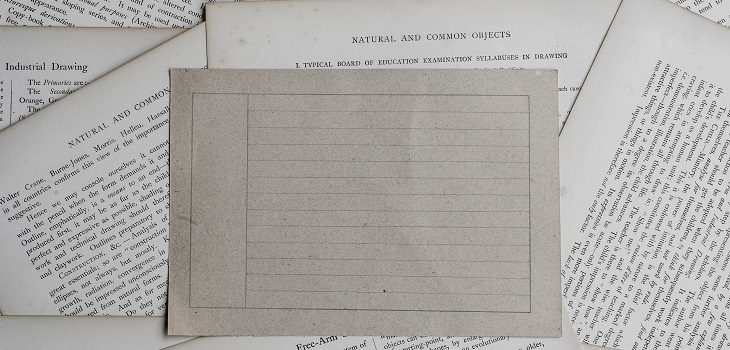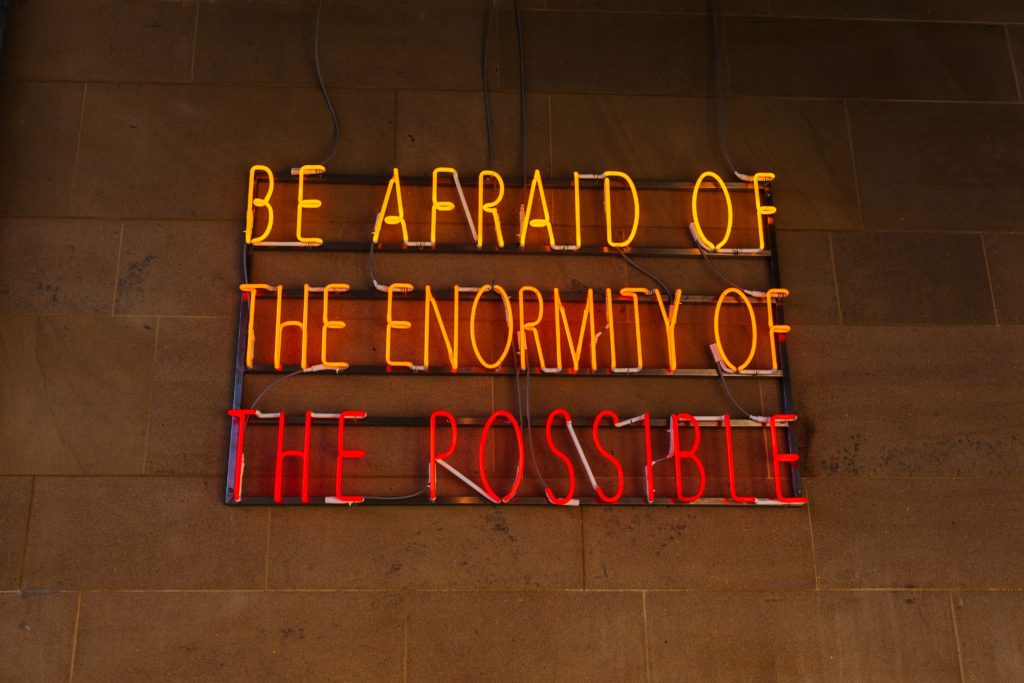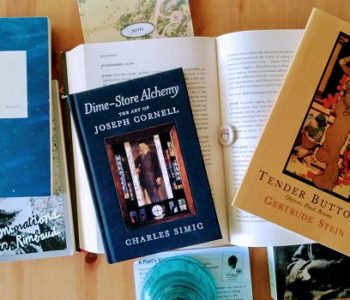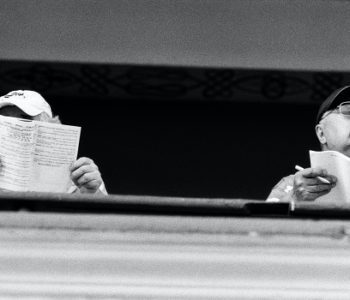 Discover Literature
Discover Literature
Dear Bad Writers, Read This Poetic Line Breaks Guide
STEP UP YOUR POETRY GAME WITH BETTER LINE BREAKS AND ENJAMBMENT
What makes a poem, a poem? Long story short, poetic line breaks. Of course, many other literary elements fuse to make poems croon, but poetry is visibly distinct from prose because its lines are sundered before the page’s natural end, at clearly calculated points. Poems are dialogues between the presence that is the text and the absence that is the white space revealed.
In contrast, where a line ends in a prose piece is arbitrarily dictated by a page’s margins. Hence why “prose poems,” which don’t utilize line breaks, are qualified by the word “prose.” Every prose line runs blindly towards the brink, and once it bumps its head against the uniform white space of the margin (in LTR and RTL scripts), it starts again on the next line, replicating this headlong trajectory over and over until you have pages filled with blocks of text offset by only smidgen indents. Prose flows, but it doesn’t care where it goes.
Although line breaks build poems, many “writers” have no damn clue how to use them effectively. If you’re not taking advantage of the connotative dynamism and aesthetic value of ink abutting blankness afforded by poetic line breaks, you’re not writing the best poetry. In fact, you’re not writing poetry at all.
POETIC LINE BREAKS DEFINITION

First off, let’s define a poetic line break. Quite simply:
A poetic line break is the deliberately placed threshold where a line of poetry ends and the next one begins.
Remember, there’s a difference between a “line” and a “sentence.” A sentence is that grade-school tool that expresses a complete thought. A line is the literal linear streak of text flowing across a page. A line is a container for sentences. A line is a boa constrictor stretched across a paper road, and a sentence is the still-whole squirrel in its belly. Here are some rules to remember about lines and sentences. (The / below represents poetic line breaks and is useful in environments such as this, where space is malleable and digital devices distort).
A poetic line can contain a complete sentence:

A poetic line can also contain multiple sentences:

A poetic line can also contain a sentence and an incomplete sentence:

Or multiple sentences and an incomplete sentence:

Or just an incomplete sentence:

Or even several incomplete sentences:

Already you can see that there’s much we can do within a poetic line. Think of a line as container, a bottle. Inside it, we let sail small ships of sentences and their fragment dinghies.
ENJAMBMENT IS THE KEY TO THE BEST POETIC LINE BREAKS

Now we get to the good stuff (*rubs hands gleefully*). Poetic line breaks can be just as boring as prose’s headlong flow if we schism every line at an “end stop.” An “end stop” is just another word for a period, and a period is just a little black dot that indicates that a sentence is complete. If we end at such an obvious end, our poetry becomes predictable, and this is a no-no because poetry’s greatest offering is linguistic eurekas. Thus, rather than breaking our lines at the end of each complete sentence, we should “enjamb” them.
Enjambment births sentence fragments, multi-dimensional meaning, and visual appeal through the unexpected intrusion of white space. Enjambment’s power isn’t a secret, but many “poets” — perhaps including you, dear reader — don’t fully capitalize on its potential — or worse, use it poorly. In a walnut-shell, I think of enjambment like this:
Enjambment is the point where a sentence fissures and continues on to the next poetic line.”
Let’s see how others define enjambment:
The running-over of a sentence or phrase from one poetic line to the next, without terminal punctuation; the opposite of end-stopped.”
-The Poetry Foundation
Enjambment, also called run-on, in prosody, the continuation of the sense of a phrase beyond the end of a line of verse.”
-Encyclopaedia Britannica
In other words, while I conceptualize enjambment as a point on the page, official definitions present it as a linguistic overflowing. Both modes of thinking about it are useful since enjambment’s fruit really grows from the nexus of breaking and continued meaning. Considering the specific point at where the enjambment occurs can help you craft a more potent line break.
If you’re still confused about the distinction between enjambment and poetic line breaks, here’s an easy way to think about it. There are two types of poetic line breaks. One is end-stopped. The other is enjambed. Enjambed line breaks are poetic bullion.
Enjambment can also be thought of as the intimate, subtly interrupted conversation between the final word of the enjambed line, and the first word of the subsequent line. The preceding and following words, of course, chime in and contribute to the conversation, but the lover’s dialogue happens between those final and first words.
Further, because the final word of an enjambed line bears the precariousness of the brink of white space — generally more white space than its successor — because it teeters on the edge of silence — the poet must ensure that every single end word resonates. This holds true even if the poetic line break is end-stopped, but that little pebble that is a period makes the end-stopped line less vulnerable to the massive blank silence that enjambed final words are exposed to. Similarly, the first word of the subsequent line only has to bear the antecedent uniform margin/gutter, though of course this can be played with via indents and stanza breaks, but we’ll save that for another day.
RULES FOR POETIC LINE BREAKS
In any case, in every case, each poetic line break depends upon a critical choice in diction, and an awareness of its ripple effect in sound and meaning. Here are some mandatory tips to achieve the best poetic line breaks:

Never end a poetic line on an article (a/an, the). The result will be incompleteness, rather than dynamic tension.
Never end a poetic line on a conjunction (and, or, so, nor…). It’s better to have such words at the start of the next line, but it’s even better to restructure the lines so that the conjunction lives hidden amid the momentum of livelier words.
Never end a poetic line on a pronoun (I, me, mine, his, hers, theirs, yours…). These are words that accompany, not words that can jut proudly like a figurehead on a ship’s prow.
Try really hard not to end a poetic line on a preposition. The effect is similar to enjambing on articles and conjunctions, though sometimes the broken prepositional phrase can be interesting.
Line break on unusual nouns and verbs that ring strong as standalone words. As we discussed in 8 Key Literary Elements in Every Written Masterpiece, linguistic poignancy is always crucial, but it becomes critical when the strength of your diction is tested by a page’s white space.
However, be aware that enjambment can rejuvenate common, tired words (light, home, breath, and so on) like no other poetic device. Strategic line breaks are a rare opportunity to reclaim these words from their historical overuse by imbuing them with variegated connotations.
Line break at a rhythmic point to poise meaning and weave a sonic tapestry. Luckily, poetry has shed its rhyming knickers, but that doesn’t mean you can’t play with rhyme, rhythm, and so on sporadically, internally, and effectively via the pauses and acoustic cascades created by poetic line breaks. At the same time, these pauses are sonic cues to read differently, allowing for distinctions and additions in the meaning of your words, fragments, and sentences.
POETIC LINE BREAKS IN ACTION
Let’s see an example where an opportunity for enjambment isn’t capitalized upon:
Example A:

*Shakes head sadly.*
If you’re a poet, you should be having a panic attack at the missed opportunities here. And yet, I can’t tell you how many workshop — and published — poems I’ve read that miss these opportunities every single time, every single line. If we instead write:
Example B:

The poem grows a hydra-head of new meanings. Enjambing on “night” means that the container of the first line now holds the idea of dusk becoming electrifying night in the room because the reveal of the artificial night “light” is delayed by the mid-sentence poetic line break. Thus, in Example B, dusk is transformed into both the captivating night as a time of day and the literal night light that gets plugged into electrical sockets, while Example A only illustrates the latter.
Further, in example A, the second line shoots its shot all in one go; there’s no room for surprise. In contrast, Example B’s second line contains an entirely new idea because of where the line begins and end: not only are we gifted the image of the throbbing night light, and later, lost time found in the shadows, we are also given “light throbbing and lost” as an unexpected standalone nugget of meaning simply because I enjambed on the words “night” and then “lost.” This image does not exist in Example A because it wasn’t extracted through the clarity of blank space strategically created via enjambment.

Yet another dimension in meaning in Example B is achieved through the 2nd line break on “lost”, which creates the final container of “time found in the shadows.” In contrast with Example A, there’s an extra gain in Example B — not only has “lost time been found in the shadows,” time itself — and thus double time, extra time — is found there as well thanks to enjambment.
These are just a few lines, so imagine what you can do in a whole poem if you wield poetic line breaks, and more specifically, enjambment, effectively. They are tools that allow you to whittle little poems within your larger piece.
It’s important to note that enjambment doesn’t remove meaning; it simply adds different meanings. All of the ideas in Example B are present in Example A, but B contains at least three other meanings because of two simple line breaks. At the same time, be aware that you will often have to choose between additional meanings when employing enjambment. Breaking on one word versus another may create an alternative, equally powerful sub-meaning, and this is when you have to consider what enjambed connotation works better within the context of your entire poem.
Also keep in mind that poetic line breaks are an editing tool; they generally come after you first scribble down your creation. This is true for several reasons. If you hand-write your first drafts, the lines will likely sprawl out with much wider spacing than what will be in their final typeset form. When the poem gets transferred to the computer, its entire appearance changes — and since the conversation between all of a poem’s line breaks and the resulting white space result in an aesthetic that’s intrinsic to the poem’s effect, you can’t polish those line breaks until you have a sense of what your poem will look like in its ultimate form.
Secondly, regardless of the mechanics of your composition, editing is a process of both adding and cutting content, so entire lines and words can disappear or rear their heads, drastically altering the look of your poem, and the corresponding enjambment. If you try to edit according to predetermined poetic line breaks, you’re going to end up with a tortured piece whose corset is too tight to allow its words to breathe.
Poetic line breaks add to a more fulfilling experience, both from a creative perspective for you as an artist, and for your readers, breathing close to pages filled with your words as their night lights throb on and off, on and off.




24 COMMENTS
The way that these techniques are used by most modern poets are not only not visual appealing, but actually off-putting to most readers. Awkward line-breaks/enjambment can kill an otherwise decent poem. Deciding to create a new line in the middle of clause is obnoxious.
Thank you for these posts! Very useful for teaching pre-service English teachers.
I want to be taken seriously and write from the heart, but I know I get passed over because I don’t use hipster line breaks all the time. I do only when they are necessary. I submit my work, get denied, and every time when I read the work that was published, it is filled with awkward line breaks that don’t do anything to the work aside from make each lines line up straight.
I’m going to disagree with some of the things said here but I feel like I have to preface that by noting that Hanna has provided a free service here with the intent to benefit other writers and I believe that should be honored. I also can confirm that ideas presented here are consistent with things that are taught in many high level writer’s workshops such as one’s I’ve attended in my MFA program and in NYC.
Let’s start with what effective poetry is. If we consider thought versus feeling and intuition, we have a preponderance of things in our lives which occupy thought, such as science, work, daily tasks, instructions, and so on, while poetry is a counter-balancing force that occupies feeling and intuition. Poetry is powerful, every line, every verse, seething with such force that those that are receptive to it cannot help but feel. The best poetry is something only the author could write, because no matter what persona seems to be telling the poem or what external things are included, everything in the best poetry is personalized to the individual who wrote it in the same way that everything in Freudian dream theory is really an aspect of the dreamer. And poetry may be fused with other art forms, but the part of it that is poetry is meant to be read out loud, so everything on the written page will necessarily support the most effective oral reading of the part of it that is poetry.
Unfortunately, there are few great poetry writers and many, many poor ones, so much of what is written and published today is not powerful, is not something only the author could write, and often even forgets that it is meant to be read out loud. Many of these poor poetry writers are MFA students and PhD students, and, eventually many become professors of English, MFA faculty, etc. They need to publish so they learn and emphasize tricks of how to make weak poetry more interesting. One of these tricks is an obsession with line breaks and enjambment.
The example provided above is instructive. First, consider the line used in the example: “In my room dusk becomes the electric night light throbbing and lost time found in the shadows.” This is NOT a powerful line. It is overly poetic, not phonetically impressive, and what it tells you about the author is at best vague and uninteresting. So, as noted in the example above, splicing such a weak line as this at a clever point can grow “a hydra-head of new meanings,” which at least has the possibility of making the line somewhat more interesting. It couldn’t be much worse, so might as well try something.
Of course, another option is to just cut that weak line entirely or replace it with something much more powerful, but that depends on being able to write powerful lines of poetry, which many people struggle to do with any consistency. But suppose we start with poetry that is powerful, for instance: “The wind howls like a hammer, the night blows rainy; my love she’s like some raven at my window with a broken wing.” Now the discussion of these “clever” techniques in poetry becomes very different. Now, because we are starting with lines that seethe with feeling, if we vary from the natural line breaks that maximize that feeling, we may gain some “clever” thought-provoking “new meaning” but we lose some of the raw force of feeling. The natural line breaks are, of course:
The wind howls like a hammer,
the night blows rainy;
my love she’s like some raven
at my window with a broken wing.
I could instead write:
The wind
howls like a hammer,
the night blows
rainy; my love
she’s like some raven
at my window
with a broken
wing.
These breaks follow the advice of this article and what is regurgitated in many MFA and other workshops. Notice the interesting shades of meaning created by breaking “the night blows / rainy”. Unfortunately, these interesting, clever devices – which ultimately are thinking devices and not really the province of poetry at all – only destroy the emotional power of the lines as they were previously laid out. Is this second version the ideal way that this line should be read out loud? I can imagine that there are some personalities, especially heavy-thinking types that don’t pick up on emotion that well, that may prefer the second version, but those people should not be poets.
There are places where “clever” line breaks helps even a powerful poem, where the emotional disruption is minimal or is countered by even greater emotion created by the unexpected line break. When these devices are used sparingly, they can be an effective component of a poet’s toolbox. When they are used to obfuscate weak lines of poetry, I find them distasteful. Instead, focus on writing better lines of poetry!
James –
A few counterpoints:
-The Dylan lyrics you selected fit your description of weak lines of poetry. The first image is muddy and overly poetic – hammers don’t “howl,” the second line immediately evokes the cliche, “it was a dark and stormy night,” and the final two lines don’t offer anything in the way of phonetic pleasure. All we learn about the speaker is that they have a window and a love – not much insight if you ask me.
-Creating poorly enjambed lines doesn’t persuade me that enjambment isn’t a great tool. It just shows that you selected mediocre lines to start with and then made them worse by breaking them ineffectively. Remember, “wield poetic line breaks, and more specifically, enjambment, effectively… each poetic line break depends upon a critical choice in diction, and an awareness of its ripple effect in sound and meaning.” And if the enjambment doesn’t empower the poem, as in your example, you’re either using it wrong or the poem needs to be rewritten.
-Printed poems function differently than song lyrics. They are different media. Dylan’s words gain power through music. His lyrics can be poetic, but I am in the camp that they are not “poems.” Printed poems gain power through their play with the white space on the page. One of the key ways to do that is via line breaks. Hence why attempting to enjamb Dylan’s “poem” is doomed from the start.
-I will concede that my example line is nothing spectacular. (But hey, gotta’ save the best stuff for getting published.) The point I wanted to prove is that the line deepens in meaning through enjambment. Now if you could amplify every line in a poem through breaks, why wouldn’t you want to? A poem should be as powerful* as possible and effective enjambment is crucial to achieving that maximal effect. And yes, it begins with writing *powerful lines.
-You may disagree with this based on what you consider “powerful” poetry.
-Hannah
“Two roads diverged in a wood, and I—
I took the one less traveled by,
And that has made all the difference.”
Say *what* about ending with a pronoun?
I was thinking of variants of “I” endings before I stopped to recall the obvious counter-example. But using a pronoun at the end of a line calls it into peculiar emphasis, the kind that we don’t so often see anymore. It could bring up a feeling of self-doubt before action, or rage at the harms done to the self, or wonder at the beauty of the listener. I could see the evocation of a feeling similar to “Lady in Red” by Chris de Burgh: “But I hardly know… this beauty by my side; I’ll never forget… the way you look tonight” — careful wordcraft could get as much from ending a line with “you” (and the song uses “there’s just you and me,” which is a perfectly fine way to end a line).
I can see most of your other categories, but that one seems to be overlooking a lot of possibility.
Also, I came here from Google, trying to find anything that goes into the “poetry” I’ve been noticing, which appears to be just prose with quasi-random line breaks, as if line breaks alone were enough to make a poem. Not even line breaks that seem to have any strategy to them, and the “poems” don’t seem to make use of assonance or consonance, rhythm/cadence/meter or even particular imagery, which has left me baffled. Obviously you needn’t rhyme to be a poem, and free verse is a thing, but… what can be said about prose with line breaks?
Hey Hannah! It’s really helpful reading your blog. Humor, with gentle chiding left me smiling. It will sure take a while to get to where you want us to be, but we will be happy to have you teach us. Israel from Nigeria, sends his best regards.
In her prose poem “Pimento,” Naomi Shihab Nye, who recognizes she is every bit as much a singer as Bob Dylan, the same as Whitman was a singer, the same as Homer was a singer, wrote about the future Nobel Prize in Literature winner that “I would be a better singer if I sang more like Bob Dylan. Well, who wouldn’t be?” Perhaps some years in the future when your ego has healed over me calling your example line (which you yourself admit is “unspectacular”) “not powerful,” go back and read what I wrote again.
James, drop the condescension. Your rudeness is unprovoked and unwarranted. Hannah is allowed to respectfully argue and defend her position, as she has done and continues to do. It seems as though you are far more offended–nay, butt hurt–over her not finding those Bob Dylan lyrics powerful, than she is over you finding her throwaway lines (used solely for an exercise) “overly poetic” and “not powerful.”
Honestly, if you took a dose of your own advice, you’d see your Dylan excerpt not only commits the same crimes with which you charged her lines, but is also cliche. Though Hannah only addressed its first line, in my view, the entire excerpt is overly poetic. And, she is correct, that second line is evocative of “a dark and stormy night.”
This is all fine, of course, James. You are allowed to feel something from Dylan’s lyrics, just as I or Hannah or anyone else can say Dylan’s a good lyricist whose words are buoyed by his music, but his lyrics–your example, anyway–are not poetry. Songs get away with far more than poetry ever could, and the bar is much lower for what is considered poetry when it comes to singer/songwriters. Just because Dylan rises above that bar doesn’t mean his words are always elevated to poetry.
And, for what it’s worth, I felt more from a light show in a solemn room than the image of woman as a bird with a broken wing–talk about tired, hollow tropes. Perhaps Hannah’s image doesn’t tell you anything about the speaker, but it’s a jumping off point to learn more. Dylan’s poor broken-winged woman raven only tells me the speaker, though he may have women in his life, has never *seen* a woman in his life. The comparison, much like the howling hammer, doesn’t check out.
As a self-described bad poet, I do appreciate the advice offered here. One can cherry-pick any poet’s work to find examples where these rules have been broken, and indeed there are some major poets who break these rules often. I have to admit, I took a few of my favorite books off the shelf to see how often these rules were broken in my favorite work, and the answer is…. more than I would have thought. If something is called a “rule,” it should be pretty universal, with exceptions being relatively rare.
And this may be the only reason people are picking this little article apart. But the semantics of what constitutes a rule are totally beside the point, and I think what’s useful here is the concise explanation of the function of line breaks so that they can be used as expressive tools. And the author here does a nice job of spelling things out for us bad poets. Obviously, if someone tries adhering to these enumerated rules before they have really understood their expressive function, they will probably not have great results, and could even end up destroying whatever shreds of creativity they manage to get down on the page. The idea that every line needs to be some spectacular and novel creation on its own is pretty misleading, and the criticisms in this comment thread of the example lines in this article (but also of the Dylan song) are just ridiculous and pedantic. To see these little examples ripped apart is frankly just depressing, especially to those of us who are lucky if we ever write a decent line. Obviously anyone can find examples where the stated rules were broken and then ruin those examples by applying the rules. Everything with a grain of salt, people! Thanks for taking the time to spell things out for those of us who love to write but struggle.
I found a lot of value in this post and the one about 8 techniques in literature. More please!
Comparing song structure to poem structure is oranges to apples.
The line length of a song is determined by the melody while the enjambed lines of a poem are ended where the poet feels appropriate. Clever enjambment may add ambiguity or extra layers of meaning. Songs may use strong poetic imagery but they are not usually poems — unless you are talking about Leonard Cohen…
I really enjoyed this piece. The message seemed clear, whether or not one finds all of Hannah’s points relevant to one’s own work: line breaks matter. Lineation is the only tool that poets have that prose writers do not have. Poets are allowed, via line breaks, to change the reader’s breathing, to heighten the effect of the multifarious meanings of single words as they are employed in the context of a sentence. A word is changed by what comes before and after, including whether that before and after is white space. Rules, of course, are meant to be broken. Use a personal pronoun well at the end of the line (Frost, and many others) — good for you; the self-consciousness of the poem is foregrounded. End on an article? Yes, you sacrifice the integrity of the line, but perhaps you want to create the sense of unease. Thoughtful and useful work.
Loved this article. Very helpful and well written. The issue of where to end a line in free verse is a vexed one for me; I keep editing and re-editing. Different versions of the same poem have different strengths, different weaknesses. No simple answers. I found your reflection on the topic validating and helpful!
Thank you so much for this. It has already helped improve my writing.
This is just fabulous, I have learnt a lot already and I also love the constructive argument . What a place to be.
Great article. It would definitely benefit poets who are struggling with writing free verse and knowing how/when to end lines.
I thought your example was good. Could it have been done differently? Sure. Would those differences be based on the context? Yes. In other words, I think your examples are a good starting point for poets learning to write in free verse.
I enjoyed reading your instructive comments about enjambment and to my surprise your suggestions align with what I have instinctively felt.
excellent article. thank you.
Advice is just that — advice, not edicts from God. Anything can work if done well, if used appropriately. I appreciate most advice and instruction. In the end, I decide to use whatever works to satisfy my goal(s). That may be a little bit of this, a little bit of that, and a whole lot of something else. And all of that may change in the next poem, although I am beginning to become consistent as a poet. I’ve developed a poetic voice, and my voice is not sing-songy. Lyric poetry is just one form of poetry. Most of mine is dramatic.
Defensiveness is not helpful, James.
Thanks Hannah, we are still reading your articles. You scaffold the teaching of these devices coherently. You’re a great teacher. This will help me with my teaching of poetry in Australia. Keep sharing.
I LOVE THE ARITCLE
My favorite rule in poetry is there are no rules. That being said you have to know the basics to break the traditional rules in a way that elevates your piece. This post is great for doing that. Especially if one of these rules does elevate the poem when you test it.
It all depends on how you want it to be read and feeling you want the poem to illicit.
I have several poems end with you or me, but if I were to remove that the meaning and feeling would be lost. It’s all dependent on each piece, imo.
I came to this article because I have been utterly baffled by the odd use of line breaks in modern poetry. Thank you for helping me to understand the effective uses of enjambment; it resolved a lot of misunderstandings for me. I also now realize that one of my confusions has come from the all too prevalent improper use of the technique. And I benefited from the discussion in the comments that details some exceptions to the rules, as well as other things to consider about what makes good poetry. This has been really helpful.
To the more aggressive counter-argument in the comments, I would like to submit that while I find your points quite educational, your wisdom will be received much more widely if you drop the arrogance; it becomes a sound barrier that the people you might hope to edify cannot hear through. Showing gratitude first for what has been said leaves people more open to hear what you might say to enhance the discussion. Decency opens doors.